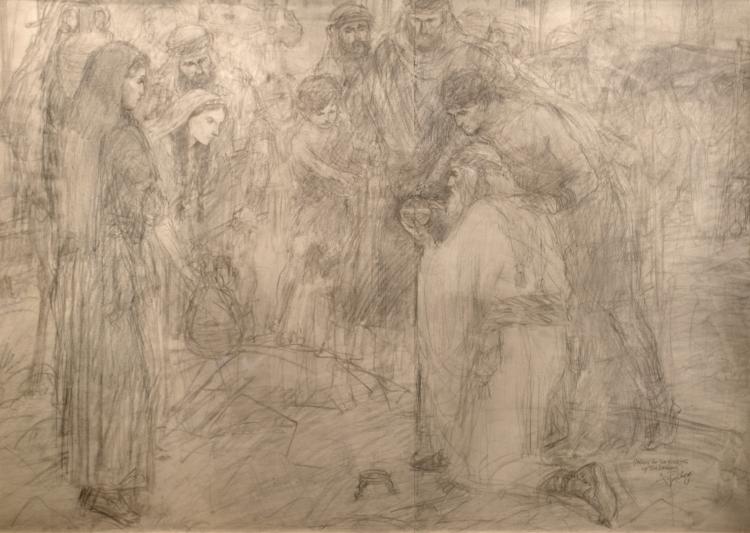You are here
Study of "Lehi in the Wilderness Discovers the Liahona"
| Title | Study of "Lehi in the Wilderness Discovers the Liahona" |
| Publication Type | Artwork |
| Year of Publication | Not Available |
| Authors | Friberg, Arnold |
| Keywords | Lehi (Prophet); Liahona; Wilderness |
| Abstract | Graphite on Paper 22 3⁄4 x 31 1⁄2 in. 1 Nephi 16:10 Signed “A. Friberg” Perhaps the most memorable work of Friberg’s Book of Mormon paintings, Lehi in the Wilderness Discovers the Liahona, is familiar to nearly all members of The Church of Jesus Christ of Latter-day Saints. For some, its familiarity may undercut the inventiveness and originality of Friberg’s work, which—as was true for all his Book of Mormon paintings— was the result of many studies detailing every aspect of the painting. As shared by Dr. Vern Swanson, Friberg struggled to determine even minute aspects of the work. In the artist’s words:
Although, the Liahona takes up a small amount of space within the image, it is the focus of the entire composition. To accomplish this sense of focus, Friberg both directs the actual gazes of all the figures in the work towards the Liahona, and, employing his classical training, uses the Golden Mean, a mathematical equation found in nature and used by artists since antiquity, to naturally draw the viewer’s gaze. In addition to his well thought out compositional plan, Friberg did separate portrait studies of each individual. Friberg used models encountered in his various social circles, including friends, family, his home teachers, and actors working on the set of The Ten Commandments (1956), where he was employed by director Cecile B. DeMille to help with the conceptualization of sets and costumes. After arriving at his desired result in a separate portrait, each character in Friberg’s paintings remains consistent throughout Friberg’s subsequent oeuvre. In the Book of Mormon, both the Liahona itself and the symbol of the Liahona serves as a metaphor for God’s relationship with his covenant people. After it was found by Lehi (1 Nephi 16), Nephi describes its workings:
The Liahona was instrumental in helping Lehi and his family find food, receiving directions in the wilderness, and guiding their ship towards the Promised Land. Several generations later, the prophet Alma describes the Liahona in symbolic terms:
|
Terms of Use
Items in the BMC Archive are made publicly available for non-commercial, private use. Inclusion within the BMC Archive does not imply endorsement. Items do not represent the official views of The Church of Jesus Christ of Latter-day Saints or of Book of Mormon Central.
Bibliographic Citation
Scripture Reference
Subscribe
Get the latest updates on Book of Mormon topics and research for free

